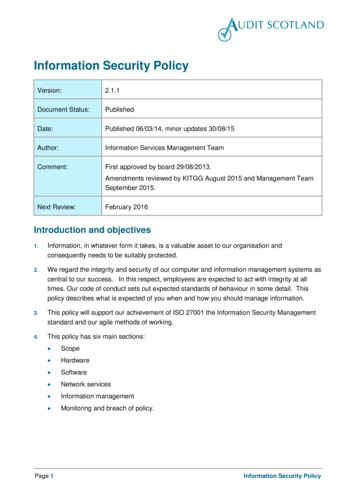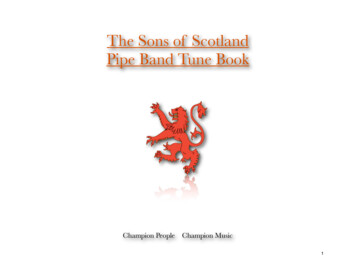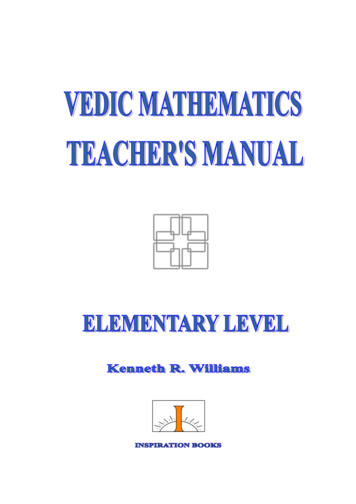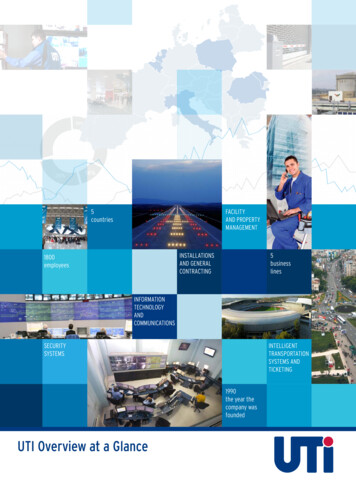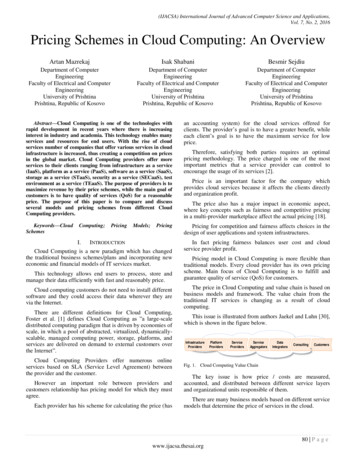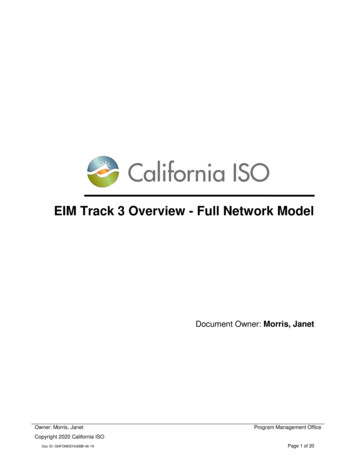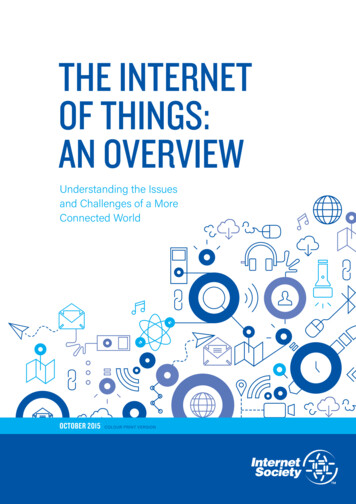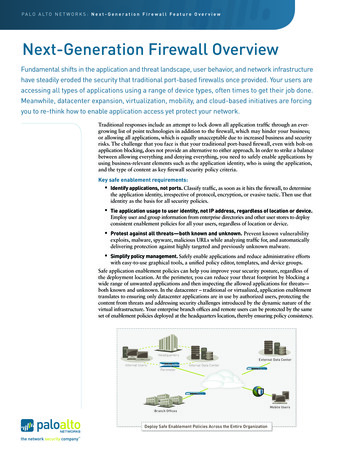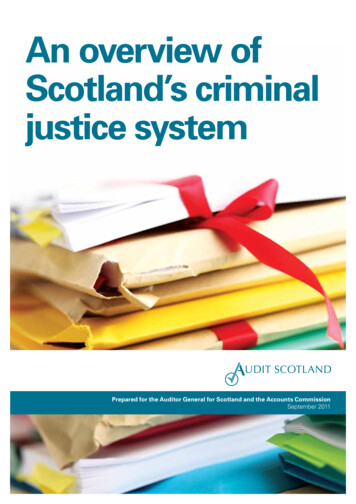
Transcription
An overview ofScotland’s criminaljustice systemPrepared for the Auditor General for Scotland and the Accounts CommissionSeptember 2011
Auditor General forScotlandThe Auditor General for Scotland is the Parliament’s watchdog for helpingto ensure propriety and value for money in the spending of public funds.He is responsible for investigating whether public spending bodies achievethe best possible value for money and adhere to the highest standards offinancial management.He is independent and not subject to the control of any member of the ScottishGovernment or the Parliament.The Auditor General is responsible for securing the audit of the ScottishGovernment and most other public sector bodies except local authorities and fireand police boards.The following bodies fall within the remit of the Auditor General: directorates of the Scottish Governmentgovernment agencies, eg the Scottish Prison Service, Historic ScotlandNHS bodiesfurther education collegesScottish WaterNDPBs and others, eg Scottish Enterprise.The Accounts CommissionThe Accounts Commission is a statutory, independent body which, through theaudit process, requests local authorities in Scotland to achieve the higheststandards of financial stewardship and the economic, efficient and effective useof their resources. The Commission has four main responsibilities: securing the external audit, including the audit of Best Value andCommunity Planning following up issues of concern identified through the audit, to ensuresatisfactory resolutions carrying out national performance studies to improve economy, efficiency andeffectiveness in local government issuing an annual direction to local authorities which sets out the range ofperformance information they are required to publish.The Commission secures the audit of 32 councils and 45 joint boards andcommittees (including police and fire and rescue services).Audit Scotland is a statutory body set up in April 2000 under the PublicFinance and Accountability (Scotland) Act 2000. It provides services to theAuditor General for Scotland and the Accounts Commission. Togetherthey ensure that the Scottish Government and public sector bodies inScotland are held to account for the proper, efficient and effective use ofpublic funds.
An overview of Scotland’s criminal justice system 1ContentsSummaryPage 2Part 2. The cost of criminal justicein ScotlandPage 15The length of time taken to processcases has improved but the processis still inefficientKey messagesThe criminal justice system cost anestimated 857 million in 2009/10Page 16Inefficiencies in processing casesthrough court cost the criminaljustice system at least 10 millionin 2009/10Page 27New legislation and case law havecost implicationsPage 18Improving the efficiency of thecourt system could deliver savingsPage 30The criminal justice system isdemand led and managing demandis difficult for some bodiesPage 19Part 4. Effectiveness in reducingreoffendingPage 32BackgroundSummary of key messagesPage 3RecommendationsPage 4Part 1. How Scotland’s criminaljustice system worksPage 5Key messagesScotland’s criminal justice system iscomplexPage 6Many bodies are involved withdifferent roles and accountabilitiesThe criminal justice system dealswith a large number of cases andinvolves many different peopleThe criminal justice systemfocuses on ensuring due processis followed, rather than meetingpeople’s needsPage 8Scotland’s criminal justice systemhas changed significantly sincedevolutionPage 10Joint working among criminaljustice bodies has improved inrecent yearsPage 13Budgets of the main criminal justicebodies have reduced in 2011/12Page 20There are risks to the long-termsustainability of servicesPage 22Part 3. Efficiency of the criminaljustice systemPage 23Key messagesThe efficiency of the criminal justicesystem could be improvedIncompatible IT systems andlimited sharing of information leadto inefficienciesPage 24Performance information is of limiteduse when planning improvementsacross the whole systemPage 26Key messagesReoffending is a common andcostly problemThere has been little progress onthe Scottish Government’snational indicator to reduce thereconviction ratePage 33In 2009/10, an estimated 81 millionwas spent by criminal justice bodieson services to reduce reoffendingServices to support offendersand reduce reoffending varyacross the countryPage 34Performance information onthe effectiveness of services toreduce reoffending is limitedand inconsistentPage 37Funding arrangements arecomplex and there are risks tofuture service deliveryPage 38Appendix 1. Audit methodologyPage 39Appendix 2. Project advisory groupmembersPage 40
2SummaryScotland’s criminal justice system consistsof a complex set of processes involvingmany different bodies and individuals.
Summary 3Background1. The criminal justice system inScotland consists of a complex set oflegal processes based on principles offairness, a respect for human rightsand independent decision-making.It is adversarial in nature, whichmeans the two sides involved in acriminal case oppose each other incourt. The system must follow dueprocess to ensure the protection ofindividuals accused by the State andthe presumption of innocence untilproven guilty.2. There are many different public,private and voluntary bodies andindividuals involved in deliveringcriminal justice in Scotland. Thebodies have different roles andaccountability arrangements toensure that the power of the Stateis separated from the processes ofmaintaining and upholding the law,which is a fundamental principle indemocratic societies.3. For this audit, we defined thecriminal justice system from whenthe police identify someone theyconsider has committed somecriminal activity until that personleaves the criminal justice system.For example, when they are foundnot guilty by a court, pay a fine orcomplete a prison or communitysentence. We only considered theadult criminal justice system.1 Theaudit focused on criminal justiceprocesses, activities and performance.Prosecutorial and sentencingdecisions are independent ofgovernment and were not considered.4. In 2009/10, an estimated 857 million was spent supportingScotland’s criminal justice system.Most police expenditure and activityis concerned with maintainingpublic safety and the prevention anddetection of crime, which are outside12the scope of this audit. This figuretherefore only includes an estimatedproportion of police expenditure directlyrelated to criminal justice activities.5. The criminal justice system hasan important role in achieving threeof Scotland’s national outcomes asset out in the National PerformanceFramework:8. Evidence for this overview is basedon analysis of national and local data,reviews of existing research, andinterviews with staff from across thecriminal justice system. A descriptionof our methodology is provided inAppendix 1 and details of our advisorygroup in Appendix 2.9. This report is divided into four parts: We live our lives free from crime,disorder and danger. Part 1. How Scotland’s criminaljustice system works. We have strong, resilient andsupportive communities wherepeople take responsibility for theirown actions and how they affectothers. Part 2. The cost of criminal justicein Scotland. Our public services are highquality, continually improving,efficient and responsive to localpeople’s needs. Part 4. Effectiveness in reducingreoffending.6. There are two national performanceindicators to assess progress againstthese outcomes relating specifically tothe criminal justice system: Increase the percentage ofcriminal cases dealt with within26 weeks by three percentagepoints by 2011 (from 66 per centin 2006/07). Reduce overall reconviction ratesby two percentage points by 2011(from 44 per cent for 2004/05cohort).27. The aim of our audit was toprovide an overview of how muchpublic money is spent on Scotland’scriminal justice system; to determinewhat that money delivers in termsof activity and performance; and toidentify where there is potential toimprove efficiency and effectiveness.We also intend to use the findingsfrom this overview to identify areaswhere more detailed performanceaudit work would be of value. Part 3. Efficiency of the criminaljustice system.Summary of key messages There have been significantchanges to the criminal justicesystem since devolution, whichhave delivered major reformbut have also contributed toits complexity. It is difficult tomanage criminal justice processesas a whole system because ofthe number of bodies involvedand their different accountabilities.However, joint working hasimproved in recent years. The operation of Scotland’scriminal justice system costan estimated 857 million in2009/10. The revenue budgetfor the six main criminal justicebodies (excluding police) reducedby seven per cent in real terms in2011/12; and the capital budgetby 64 per cent. The scale of thebudget reductions, combined withincreasing cost pressures in someareas and limited control overdemand mean there are risksto the long-term sustainability ofcriminal justice services.We have not included offenders held in The State Hospital.This indicator measures the number of people who are reconvicted within two years of completing a sentence. The baseline was set in 2007, so wasbased on reconvictions of people first convicted in 2004/05.
4 There are significantinefficiencies in the criminaljustice system. Incompatible ITsystems create inefficienciesand differences in performanceinformation make it difficultto plan improvements acrossthe system as a whole. Thelength of time taken to processsummary cases through thecourts has improved, but manycases still repeat stages in thecourt process. Inefficienciesin processing cases cost thecriminal justice system atleast 10 million in 2009/10.Repeated delays in processingcases can also have a negativeeffect on people’s confidence inthe system. Reoffending is a continuingproblem in Scotland. There hasbeen little progress towards theScottish Government’s nationalindicator to reduce reconvictionrates, which have fallen byless than one per cent in thelast three years. We estimatethat in 2009/10, around 81million was spent by criminaljustice bodies (excluding police)directly on services to reducereoffending. This is less thanten per cent of total criminaljustice expenditure. Theavailability of services to supportoffenders varies across thecountry and information on theeffectiveness of these servicesis limited and inconsistent.RecommendationsThis report is intended to providean overview of the criminaljustice system in Scotland. Wedid not look at any individual partof the system in sufficient depthto enable us to make specificevidence-based recommendations.However, there are a number ofareas where there is clear potentialto improve the efficiency andeffectiveness of the criminal justicesystem. In particular, there needsto be significant improvement in: how well victims andwitnesses are supported andkept informed about what ishappening in their case the availability of cost andperformance informationto support the effectivemanagement of both individualorganisations and the systemas a whole. This wouldimprove understanding of thereasons behind inefficienciesin the system and variation inperformance across the country the efficiency with whichsummary cases are processedthrough court to reducesubstantially the number ofcases which repeat stages andthe number of cases which areresolved later than necessary how services for offenders arefunded and delivered across thecountry to ensure they meetdemand and are focused on themost cost-effective approachesto reducing offending behaviour.10. The Scottish Government andcriminal justice bodies acknowledgethe importance of these issues andare beginning to address them. Werecommend that they build on therecent progress in joint working and,as a matter of urgency, collectivelyidentify, agree and implementactions to deliver the necessaryimprovements. This joint approachshould ensure that the workundertaken delivers benefits across thesystem as a whole and avoid the riskthat changes designed to improve theprocess in one part of the system havea negative effect on a different part.11. Delivering significantimprovements to the efficiency andeffectiveness of Scotland’s criminaljustice system requires continuedstrong leadership from all the criminaljustice bodies. Agreeing measuresfor the system as a whole, whichrecognise cost and quality as wellas time, and holding relevant bodiesand individuals to account for theirperformance and contribution to thesemeasures would support this process.12. The Auditor General and AccountsCommission will consider the findingsin this report and, in consultationwith criminal justice bodies and otherstakeholders, identify where moredetailed performance audit workwould add value. This is likely to bein one of the areas identified abovewhere there is a clear potential toimprove value for money.
5Part 1. HowScotland’s criminaljustice system worksThere have been significant changesto Scotland’s criminal justice systemsince devolution.
6Key messages Scotland’s criminal justicesystem consists of a complexset of processes and manydifferent bodies are involved.There have been significantchanges to the criminal justicesystem since devolution, whichhave delivered major reformin some areas but have alsocontributed to its complexity. It is difficult for the criminaljustice process to be managedas a whole system becauseof the number of bodiesinvolved and their differentaccountabilities. Joint workingamong the main criminaljustice bodies has improvedin recent years. However,agreeing and implementingany changes depends on ashared commitment from all thecriminal justice bodies at bothnational and local levels.Scotland’s criminal justice systemis complex13. Scotland’s criminal justicesystem consists of a number ofinterdependent processes, based ona complex combination of commonlaw, stat
New legislation and case law have cost implications. Page 18. The criminal justice system is demand led and managing demand is difficult for some bodies. Page 19. Budgets of the main criminal justice bodies have reduced in 2011/12. Page 20. There are risks to the long-term sustainability of services. Page 22 Part 3. Efficiency of the criminal justice system Page 23. Key messages The
